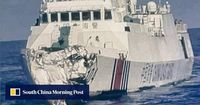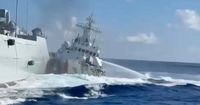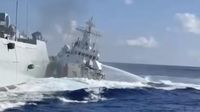On Monday, August 11, 2025, the already simmering tensions in the South China Sea boiled over into a dramatic and dangerous maritime incident near the Scarborough Shoal, a disputed atoll that has long been a flashpoint between China and the Philippines. Two Chinese ships—a navy destroyer and a coast guard vessel—collided while both were attempting to intercept the Philippine Coast Guard’s BRP Suluan, which was on a mission to protect Filipino fishermen operating in their traditional fishing grounds.
According to the Associated Press, the collision resulted in visibly heavy damage to both Chinese ships, particularly crumpling the bow of the coast guard vessel and leaving it unseaworthy. Video footage released by the Philippine Coast Guard shows the Chinese navy ship, identified by bow number 164, ramming into the bow of its own coast guard ship as both vessels tried to block the BRP Suluan. The footage also captured the Chinese coast guard using water cannons in an attempt to drive the Philippine vessel away from the shoal.
The Philippine authorities were quick to offer assistance. Commodore Jay Tarriela of the Philippine Coast Guard stated, "The Philippine Coast Guard immediately offered support, including assistance with man-overboard recovery and medical aid, but received no response." Despite fears of injuries among the Chinese crew, there were no official reports of casualties, though the Chinese coast guard did conduct search and rescue operations following the crash, according to IP Defense Forum.
The confrontation was the latest in a series of escalating encounters in the South China Sea, a region where China claims nearly all the maritime territory—including areas that fall squarely within the Philippines’ internationally recognized exclusive economic zone (EEZ). The Scarborough Shoal, located about 120 nautical miles west of the Philippines’ main island of Luzon and roughly 600 nautical miles from China’s southernmost province of Hainan, has been a particular point of contention. Manila, for its part, has consistently supported its fishermen in these waters, distributing food and ice to local crews and maintaining a presence to assert its rights.
General Romeo Brawner Jr., Chief of Staff of the Armed Forces of the Philippines, did not mince words in his assessment of the incident. Speaking to reporters in Manila, Brawner said, “China’s aggressive actions were very clear in this incident. They were at fault because of their aggressive maneuvers. We were there to protect Filipino fishermen in the Scarborough Shoal. That was our only objective because that’s our traditional fishing ground.” He further emphasized that the deployment of China's People’s Liberation Army (PLA) navy to the area marked a notable escalation in tactics. “Now they are deploying their PLA navy, and this is one symbol of China’s aggressiveness,” Brawner said. “We’ll discuss possible steps and our future tactics to counter China’s actions to stop us from getting access [to Scarborough].”
China, however, presented a starkly different account. Gan Yu, a spokesperson for the Chinese coast guard in Beijing, asserted that the Philippine vessels had “intruded into Chinese territorial waters off the shoal,” prompting Chinese forces to take what he called “necessary measures, including monitoring, forcing, intercepting and controlling the Philippine vessels to expel them.” He insisted that Chinese actions were “resolutely safeguarding China’s territorial sovereignty and maritime rights and interests.” Notably, the Chinese side did not acknowledge the collision or possible casualties in its official statements, a pattern that outside observers say reflects Beijing’s reluctance to admit operational errors or mishaps.
The United States, a longstanding treaty ally of the Philippines, swiftly condemned what it described as the “latest reckless action by China directed against a Philippine vessel.” This latest episode has only added to the chorus of international voices urging Beijing to respect international law and the rules of the sea. According to IP Defense Forum, nations worldwide have repeatedly called on China to avoid dangerous maneuvers and to abide by established maritime norms, but those calls have largely gone unheeded.
Observers and analysts have raised pointed questions about China’s decision to deploy a navy destroyer to the disputed atoll, which they say violates a 2012 agreement not to send naval vessels to the Scarborough Shoal. Lyle Morris, an analyst with the Asia Society Policy Institute, commented on X (formerly Twitter), “When the operational culture of a navy/coast guard is to habitually violate COLREGS [Convention on the International Regulations for Preventing Collisions at Sea] and norms of professionalism, this is the tragic result.”
This collision is just the latest in a long-running pattern of confrontations between Chinese and Philippine vessels in the South China Sea. Since a landmark 2016 arbitral tribunal ruling invalidated China’s sweeping maritime claims, Beijing has continued to deploy coast guard, naval, and maritime militia ships to block, ram, and harass Philippine civilian, law enforcement, and military vessels operating within Manila’s EEZ. The tribunal also found that China had violated Filipinos’ traditional fishing rights by trying to block them from the Scarborough Shoal, but Beijing has refused to recognize the decision.
Amid these maritime tensions, China’s internal political situation has added another layer of unpredictability. As reported by The New York Times and Foreign Affairs, Beijing’s military leadership is facing what some analysts call the “most serious leadership disarray” in years. Since the 20th National Party Congress in October 2022, over 20 senior military officers from all four branches—the army, navy, air force, and rocket force—have either vanished from public view or been removed from their posts. The Central Military Commission, which oversees the armed forces, currently has three vacancies following a series of arrests and disappearances tied to General Secretary Xi Jinping’s anti-corruption campaign. This internal turbulence, The New York Times notes, is testing Xi’s efforts to build a loyal, modern, and combat-ready military firmly under his control.
For the Philippines, the immediate concern remains the safety and rights of its fishermen and the protection of its sovereign waters. General Brawner indicated that the Philippine military would consult with the coast guard and seek guidance from President Ferdinand Marcos Jr. on how best to respond to what he described as China’s increasing use of military force against civilians. The stakes, both for regional stability and for the livelihoods of ordinary Filipinos, could hardly be higher.
As the waves settle around the battered ships near Scarborough Shoal, the broader struggle for control of the South China Sea continues—marked by legal disputes, diplomatic protests, and, sometimes, dangerous encounters on the high seas. The world watches, wary that the next collision might trigger consequences far beyond the horizon.






